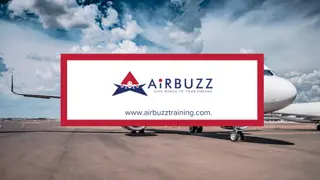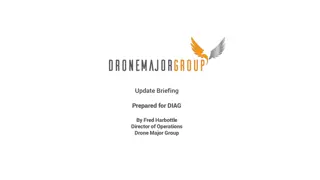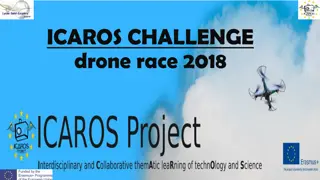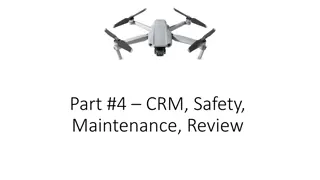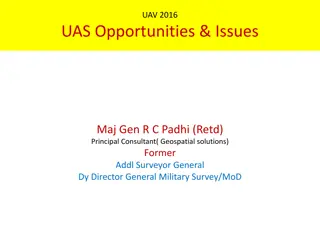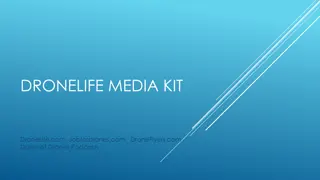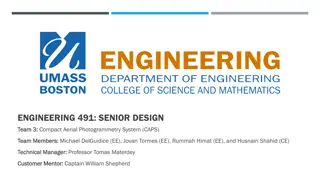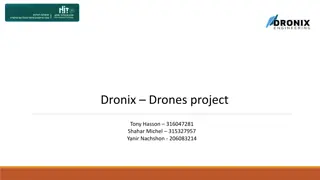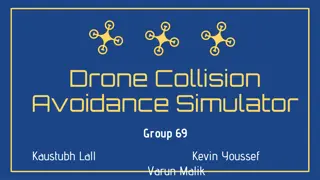Drone Pilot Health and Safety Guidelines
Understanding the importance of maintaining good health and following safety protocols is essential for drone pilots. This includes being in good general health, taking breaks for eating and drinking, being cautious with medicines, and avoiding alcohol and recreational drugs. Neglecting these factors can compromise the ability to operate drones safely and effectively.
Download Presentation

Please find below an Image/Link to download the presentation.
The content on the website is provided AS IS for your information and personal use only. It may not be sold, licensed, or shared on other websites without obtaining consent from the author.If you encounter any issues during the download, it is possible that the publisher has removed the file from their server.
You are allowed to download the files provided on this website for personal or commercial use, subject to the condition that they are used lawfully. All files are the property of their respective owners.
The content on the website is provided AS IS for your information and personal use only. It may not be sold, licensed, or shared on other websites without obtaining consent from the author.
E N D
Presentation Transcript
THE HUMAN FACTOR IN DRONES G. PARODI
SPIRIT OF THE NORM Regulation on pilot health derive from the aviation. There are some differences in the long-term habits, but not for the recommendations on day of the flight. In the following we will review the norms for drone pilots.
GENERAL HEALTH You must be in good general health to operate a UA. If you are not feeling well you cannot respond quickly if anything unexpected happens. If you are very tired or stressed, you also cannot respond quickly and you are more likely to make mistakes. In those cases, you must not operate a UA. Make sure you sleep well, prepare your work well and get to the work site on time without having to rush. You will then feel better and do a better job. Food poisoning can affect you quickly. If, after eating, you start feeling unwell you must stop the UAS operation immediately.
BREAKS FOR EATING AND DRINKING If you work all day without taking a break to eat something, then your blood sugar level can get too low. This can make you dizzy and clumsy. The same can happen if you do not drink enough. Those on a diet or fasting, whether for personal or religious reasons, must consider how it affects your performance. Taking regular breaks will also avoid stress and will help you do your work more effectively.
MEDICINES If you take medicines when you operate a UAS you must always check the medicine information leaflet. Some prescription medicines can make you drowsy (sleepy): the information leaflet will tell you not to operate machinery or drive a car. In that case you must not operate a UA. Some over-the-counter (non-prescription) medicines have the same effect. Examples include: hay fever and anti-allergy medicines (anti-histamines), decongestants (to unblock your nose) and cold and fever remedies. There are hay fever medicines which do not cause drowsiness: ask the pharmacist for information. You must be especially careful when you use medicines you have not used before. It is best to wait a few days to see if they affect your ability to operate a UAS.
ALCOHOL AND RECREATIONAL DRUGS You must make sure that your ability to operate a UA is not affected by alcohol or recreational drugs. After drinking alcohol, you must wait at least 10 hours before operating a UAS (this is the legal requirement). But 24 hours is safer (this is the recommendation for airline pilots), especially if you drank a lot. The maximum permitted alcohol concentration in blood or breath is much lower for aviation operations than for driving a car.
VISION: FACTORS INFLUENCING VLOS Mostly you fly VLOS!. You need eyesight training. YOU NEVER LEAVE THE DRONE UNATTENDED if you flight without an assistance or FPV. VLOS allows awareness and quick reactions. Apart from physiological issues. Use of prescript glasses )or not) is in the license!. Factors affecting vision: Objects: such as trees, fences, vehicles and buildings. May break the vision and link. Weather - such as fog, rain, wind and hail. Check the weather forecast. Sunlight - direct or reflections. Check sun positioning during pre-flight. If you must close your eyes because it is too bright, then won t see the drone: sunglasses. Distractions - such as loud noises, chatter, movement in your surroundings and curious bystanders. Care with the background colors.
VISION: DEPTH OF PERCEPTION You need to create 3D awareness using more than one sense! Depth perception is the ability to determine distance between you and an object, or in this case your UA. Subtle changes in size, colour, contrast, and movement affect how far away we perceive an object to be. When observing an object on the ground you have relative references, you can easily judge the distance between it, you, and other objects. But in the sky it is much more difficult. Determining the distance between a UA and objects behind it is particularly difficult, because there are no cues to help you other than the relative size of the object which is not easy to determine accurately with the naked eye. Solution: Position and observer laterally between the UA and the object in such a way that they can observe the distance laterally left and right as mentioned above. If the drone has proximity sensors, that helps to mitigate the problem. Judging distance laterally left and right is much easier because you can use the background as a reference, and if you keep the background observable between the drone and an object then you know that they won t collide.
SPEED The speed at which an object, or UA, is travelling is very difficult to accurately gauge. You need to have a reference, whether the ground or a close background, to help you estimate speed, but even then it is not easy. I f equipped with GPS, the drone can measure its ground speed and display it to you. In most cases you can set a maximum speed for your UA, so that it will not fly faster than what is safe or permitted. (During mapping, speed is part of the setting of the mission)
HEIGHT Heights can be more easily determined when looking at the UA from the side. Flying over your head makes it more difficult, as well as disorientating. There are some visual effect when you fly close to the horizon making the drone appear to fly closer to you. The best way to determine the height of your drone is to use an altimeter, which most UAs come equipped with. Rangemeters are useful instrument for mission planning.
Field of vision NIGHT VISION At low light levels you see less clearly, and you can hardly see colours, especially from a distance. This is known as night vision. If you go from a bright area (indoors) into a dark area (outdoors) then your eyes need time to adapt. This can take more than half an hour and takes longer as you get older. With night vision your peripheral vision is sharper than your central vision, so a good method for seeing better at night is to look slightly to the side of what you are focussing on. Field of regard
TIREDNESS (FATIGUE) A fatigued pilot will be sluggish and slow to react to unexpected situations. Tiredness (fatigue) has the same effects as stress: You make more mistakes Everything takes you longer It is more difficult to concentrate It is more difficult to deal with anything unexpected The quality of your work goes down Acute fatigue: starts suddenly: hard work, too long, poor sleep. Good planning, sleep, with breaks and slacks. Chronic fatigue: similar as before but for longer periods. Fatigue building .
IM SAFE An I M SAFE checklist is compulsory. If you don t pass it before flying, you cannot fly
SITUATIONAL AWARENESS This term refers to the combination of observation, comprehension and decision making. It means a continuous perception of all the elements within the observable environment of your operation and that you can anticipate future situations. Assess which elements need to be acted upon and how to manage them. During flight situational awareness includes: observing the distance between the UA and surrounding obstructions hearing and understanding information provided by other team members monitoring the status of your UAS looking out for other air users maintaining a listening watch being aware of changing weather conditions keeping your team informed predicting possible public encroachments Situational awareness is understanding all this information, knowing whether things are as they should be or not, and taking the necessary measures to ensure an acceptable level of safety.
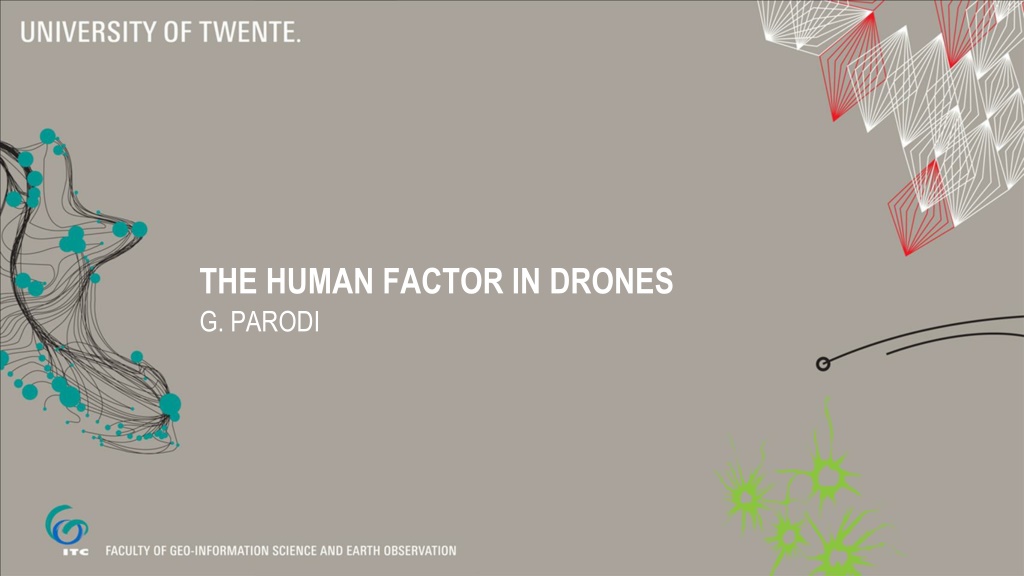
 undefined
undefined








